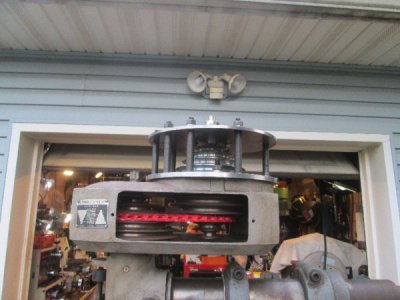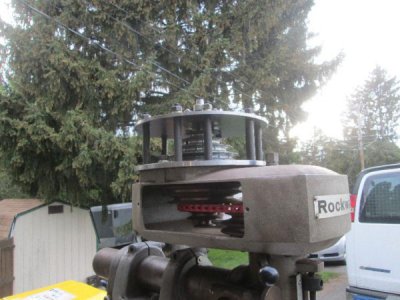B
Buffalo20
Forum Guest
Register Today
I have decided at this point, to run the new Rockwell mill, with a single phase motor. Whether its going to be 120 vac or 240 vac, I'm uncertain, the 3/4 hp motor I have can go either way. With the 1725 rpm of the motor, I'll end up with 6 speeds, 370 rpm in low and 6300 rpm in high.
I've decided to build a "transmission", like I did for the Jet mill, adding a 4 step layshaft between the mill head and the motor. I'm building it to be a cartridge, to allow the mill to be returned to original configuration, within about 15 minutes, drilling no holes, using the manufacturer's original holes. Also reusing the original motor drive sheave.
So today I went to Graingers, for (2) sheaves (pulleys) and (2) 5/8" plate bearings. Then to the local machine shop supplier, for 5 feet of 5/8" ground and polished shafting. Then to the metal suppler for some tubing, then to the industrial supplier for some nuts and bolts.
I cut out (2) 10-1/2" discs, one of of 1/4" plate, and one out of 3/8" plate, then trued them up on the lathe. I laid out the bolt placement and drilled the holes on the 1/4" plate. Transferred the hole to the 3/8" plate, then threading the required holes in the 3/8" plate. Took a piece of the 5/8" shafting and set up the Jet mill, to cut a 3/16" keyway.
The cut up some 1/4" pipe nipples, to 3" long, the bored them out to 25/64", so some 3/8"-16 B-7 allthread would pass though to make the spacers.
Then assembled the "transmission" set, placed it on the mill and set the correct sheave height, so the belt was aligned properly. Set the new drive sheave height and tightened the bearing collars and shaft collars.
So today, I used the lathe, the Jet mill, the Jet drill press with the tapping head, the Franken-Drill, the belt grinder and finally the new saw. The shop was quite a mess.
Here are a few pictures of the work so far, next up is the motor mounting brackets and the wiring.

I've decided to build a "transmission", like I did for the Jet mill, adding a 4 step layshaft between the mill head and the motor. I'm building it to be a cartridge, to allow the mill to be returned to original configuration, within about 15 minutes, drilling no holes, using the manufacturer's original holes. Also reusing the original motor drive sheave.
So today I went to Graingers, for (2) sheaves (pulleys) and (2) 5/8" plate bearings. Then to the local machine shop supplier, for 5 feet of 5/8" ground and polished shafting. Then to the metal suppler for some tubing, then to the industrial supplier for some nuts and bolts.
I cut out (2) 10-1/2" discs, one of of 1/4" plate, and one out of 3/8" plate, then trued them up on the lathe. I laid out the bolt placement and drilled the holes on the 1/4" plate. Transferred the hole to the 3/8" plate, then threading the required holes in the 3/8" plate. Took a piece of the 5/8" shafting and set up the Jet mill, to cut a 3/16" keyway.
The cut up some 1/4" pipe nipples, to 3" long, the bored them out to 25/64", so some 3/8"-16 B-7 allthread would pass though to make the spacers.
Then assembled the "transmission" set, placed it on the mill and set the correct sheave height, so the belt was aligned properly. Set the new drive sheave height and tightened the bearing collars and shaft collars.
So today, I used the lathe, the Jet mill, the Jet drill press with the tapping head, the Franken-Drill, the belt grinder and finally the new saw. The shop was quite a mess.
Here are a few pictures of the work so far, next up is the motor mounting brackets and the wiring.



